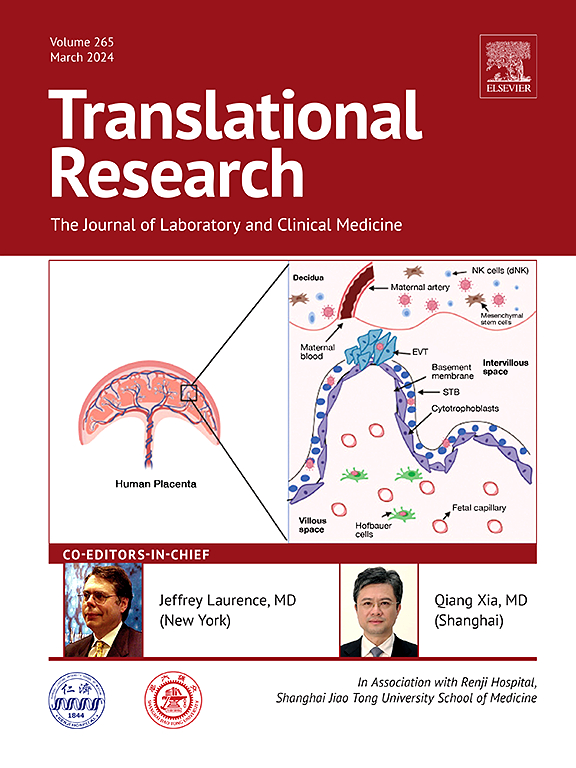Siglec-5 作为一种新型受体介导内皮细胞 oxLDL 转运,促进动脉粥样硬化。
IF 5.9
2区 医学
Q1 MEDICAL LABORATORY TECHNOLOGY
引用次数: 0
摘要
背景:氧化低密度脂蛋白(oxLDL)在内皮下的过度滞留以及随后被巨噬细胞吞噬导致泡沫细胞的形成和动脉粥样硬化的发展。我们之前的研究表明,血浆中的唾液酸结合免疫球蛋白样凝集素 5(Siglec-5)水平是糖尿病患者动脉粥样硬化预后的新型生物标志物。然而,Siglec-5在动脉粥样硬化中的作用和内在机制尚未阐明:方法:通过荧光共聚焦和共沉淀技术检测了 oxLDL 与 Siglec-5 之间的相互作用。方法:通过荧光共聚焦和共免疫沉淀检测了 oxLDL 与 Siglec-5 之间的相互作用,检测了内皮细胞和巨噬细胞中 oxLDL 对 Siglec-5 表达的影响,并研究了 Siglec-5 对 oxLDL 转运和摄取的影响。利用重组腺相关病毒载体血清型9(rAAV9-Siglec-5)在小鼠体内过表达Siglec-5,以评估Siglec-5对体内oxLDL摄取和动脉粥样硬化的影响。此外,还在体内和体外研究了Siglec-5抗体和可溶性Siglec-5蛋白对oxLDL转运和摄取的影响及其在动脉粥样硬化发生中的作用:结果:我们发现oxLDL与Siglec-5相互作用,并且oxLDL刺激Siglec-5的表达。Siglec-5能促进oxLDL的转囊和摄取,而抗Siglec-5抗体和可溶性Siglec-5蛋白都能减少oxLDL的转囊和摄取。有趣的是,通过重组腺相关病毒载体血清型 9(rAAV9-Siglec-5)过表达 Siglec-5 可促进 oxLDL 在 C57BL/6 小鼠主动脉中的滞留。此外,Siglec-5 的过表达明显加速了载脂蛋白/-小鼠动脉粥样硬化病变的形成。此外,抗Siglec-5抗体和可溶性Siglec-5蛋白都能明显减轻氧化LDL在转染rAAV9-Siglec-5的C57BL/6小鼠主动脉中的滞留以及转染rAAV9-Siglec-5的载脂蛋白-/-小鼠动脉粥样硬化斑块的形成:我们的研究结果表明,Siglec-5 是一种新型受体,可介导 oxLDL 转运并促进泡沫细胞的形成。抑制 oxLDL 与 Siglec-5 之间相互作用的干预措施,包括抗 Siglec-5 抗体或可溶性 Siglec-5 蛋白治疗,可能为治疗动脉粥样硬化提供新的治疗策略。本文章由计算机程序翻译,如有差异,请以英文原文为准。
Siglec-5 as a novel receptor mediates endothelial cells oxLDL transcytosis to promote atherosclerosis
Background
Excessive subendothelial retention of oxidized low-density lipoprotein (oxLDL) and subsequent oxLDL engulfment by macrophages leads to the formation of foam cells and the development of atherosclerosis. Our previous study showed that the plasma level of sialic acid-binding immunoglobulin-like lectin 5 (Siglec-5) was a novel biomarker for the prognosis of atherosclerosis in diabetic patients. However, the role and underlying mechanisms of Siglec-5 in atherosclerosis have not been elucidated.
Methods
The interaction between oxLDL and Siglec-5 was detected by fluorescence colocalization and coimmunoprecipitation. The effect of oxLDL on Siglec-5 expression was detected in endothelial cells and macrophages, and the effect of Siglec-5 on oxLDL transcytosis and uptake was investigated. Siglec-5 was overexpressed in mice using recombinant adeno-associated virus vector serotype 9 (rAAV9-Siglec-5) to evaluate the effect of Siglec-5 on oxLDL uptake and atherogenesis in vivo. In addition, the effects of Siglec-5 antibodies and soluble Siglec-5 proteins on oxLDL transcytosis and uptake and their role in atherogenesis were investigated in vivo and in vitro.
Results
We found that oxLDL interacted with Siglec-5 and that oxLDL stimulated the expression of Siglec-5. Siglec-5 promotes the transcytosis and uptake of oxLDL, while both anti-Siglec-5 antibodies and soluble Siglec-5 protein attenuated oxLDL transcytosis and uptake. Interestingly, overexpression of Siglec-5 by recombinant adeno-associated viral vector serotype 9 (rAAV9-Siglec-5) promoted the retention of oxLDL in the aorta of C57BL/6 mice. Moreover, overexpression of Siglec-5 significantly accelerated the formation of atherosclerotic lesions in Apoe−/− mice. Moreover, both anti-Siglec-5 antibodies and soluble Siglec-5 protein significantly alleviated the retention of oxLDL in the aorta of rAAV9-Siglec-5-transfected C57BL/6 mice and the formation of atherosclerotic plaques in rAAV9-Siglec-5-transfected Apoe−/− mice.
Conclusion
Our results suggested that Siglec-5 was a novel receptor that mediated oxLDL transcytosis and promoted the formation of foam cells. Interventions that inhibit the interaction between oxLDL and Siglec-5, including anti-Siglec-5 antibody or soluble Siglec-5 protein treatment, may provide novel therapeutic strategies in treating atherosclerosis.
求助全文
通过发布文献求助,成功后即可免费获取论文全文。
去求助
来源期刊

Translational Research
医学-医学:内科
CiteScore
15.70
自引率
0.00%
发文量
195
审稿时长
14 days
期刊介绍:
Translational Research (formerly The Journal of Laboratory and Clinical Medicine) delivers original investigations in the broad fields of laboratory, clinical, and public health research. Published monthly since 1915, it keeps readers up-to-date on significant biomedical research from all subspecialties of medicine.
 求助内容:
求助内容: 应助结果提醒方式:
应助结果提醒方式:


